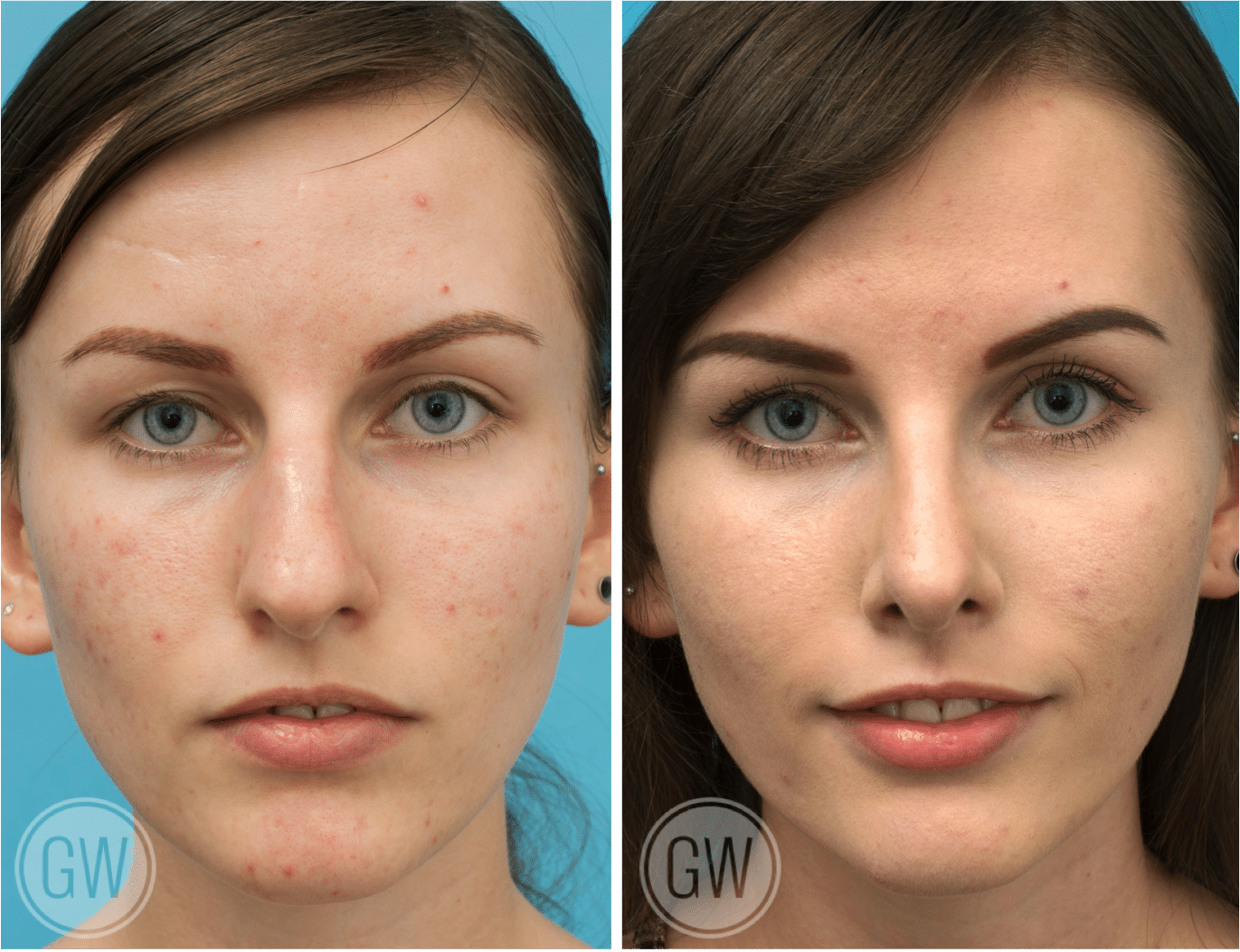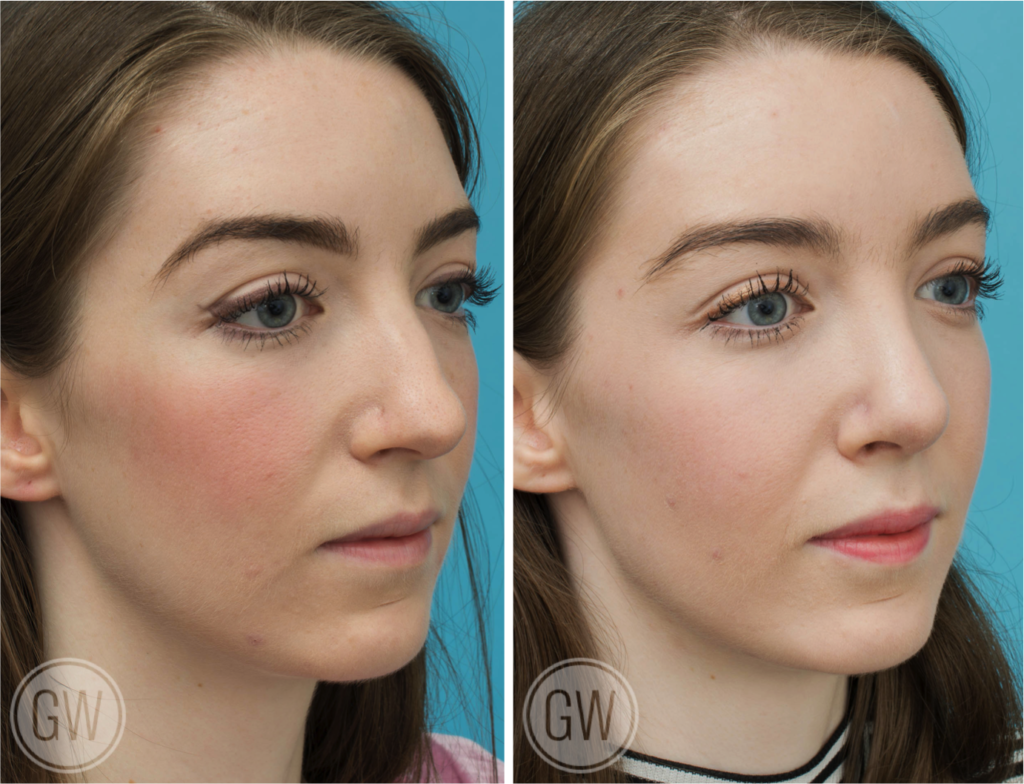
23 Sep Top 5 ways to improve your nose
Most Popular 5 Nose Job Procedures
A rhinoplasty, more colloquially known as a ‘nose job’, is a term used to describe a surgical procedure that alters the shape, size, profile and/or functionality of the nose. The nose plays an important role in determining facial symmetry and aesthetics due to its central location. Its characteristics differ from person to person, depending on the structures of bone, cartilage and skin, all of which vary with race and sex.
Nose jobs are one of the most sought-after procedures performed by Specialist Plastic Surgeon Dr Guy Watts and his team. With a wealth of a training and experience, Dr Watts will be happy to discuss your aesthetic preferences and functional needs so as to achieve excellence in results.
Nose Features and Facial Aesthetics
The various features of the nose play a crucial role in determining the overall harmony and balance of a person’s face. These features include the shape, size, and projection of the nasal tip, the width and height of the nasal bridge, the size and position of the nostrils, and the angle between the nose and upper lip. Each of these aspects contributes to the perceived attractiveness of a person’s facial appearance.
- The nasal tip is often considered the focal point of the nose, and its position, projection, and shape can greatly influence the overall attractiveness of the face. A well-defined nasal tip that is neither too round nor too pointed can create a sense of balance and harmony. Additionally, the angle between the nasal tip and the upper lip, known as the nasolabial angle, can impact the perception of the nose’s length and projection. A nasolabial angle that is too wide may create the appearance of a drooping or aged nose, while an angle that is too narrow can make the nose appear overly upturned
- The nasal bridge, which connects the tip of the nose to the forehead, also plays an important role in facial aesthetics. A wide or crooked nasal bridge can disrupt the overall symmetry of the face, while a bridge that is too high or low can make the nose appear disproportionate to the rest of the facial features. Ideally, the nasal bridge should be straight and in proportion to the width and height of the individual’s face
- Nostrils, although often overlooked, can also have a significant impact on the appearance of the nose. Large, flared, or asymmetrical nostrils can draw attention away from other facial features and create a sense of imbalance. Properly proportioned nostrils should not be too wide or narrow and should be symmetrical on both sides of the nose
Achieving harmony and balance among these features can enhance a person’s appearance and contribute to a more attractive and youthful look. Understanding the importance of these features and how they interact with one another is essential for anyone considering a procedure to improve the appearance of their nose.
Dr Guy Watts’s Take/ Surgeon’s Insight/ Expert Opinion
“The power of the human nose to balance facial features and add elegance to the facial form is profound.”
“From a profile view there should be a gentle depression between the forehead and root of the nose. The depression breaks the visual line between the two and separates the two anatomical structures.“
“In females, the dorsum should fall away slightly as you move toward the nasal tip creating a gentle curve. This concavity can add elegance and femininity to the nose.“
“In men, the line of the dorsum is straighter and may even have a small bump that can give it a more masculine trait.“
Nose Improvement Procedures – A Growing Trend
People who are unhappy with the shape, size, or contour of their nose may seek ways to improve it in order to achieve a more harmonious facial appearance.
In recent years, there has been a growing trend of individuals seeking nose improvement procedures, both surgical and non-surgical, to enhance their appearance. This trend can be attributed to the increased exposure to beauty standards through social media, advancements in medical technology, and greater acceptance of cosmetic procedures in society. Consequently, there is now a wide variety of options available for those who wish to improve the appearance of their nose, catering to different needs, preferences, and budgets.
Next, we will discuss the top 5 most popular nose job procedures that can help you achieve a more refined and aesthetically pleasing nasal appearance.
1. Dorsal Hump Reduction
Irregularities of the dorsum (or bridge) of the nose may be hereditary or as a result of trauma. A large dorsal hump (or a hook nose) is classically seen in people of Italian and Middle Eastern descent.
Techniques used for the refinement of the hump depend on the underlying structures involved. Bony convexities are meticulously sculpted or ‘sandpapered’ down with the use of a rasp. This allows for your surgeon to feel for shape and contours between adjustments and helps to ensure aesthetic precision. Cartilage associated with the hump is shaved off with precision, ensuring a straight line is formed between the nasal bone and the tip of the nose.
2. Upturning Of the Nasal Tip
The plunging or drooping appearance of the nasal tip gives an impression of a prominent hump in this region. The structure of the lower two-thirds of the nose lends itself to two paired cartilaginous structures. A drooping tip results from a downward rotation of the lower cartilages, hence, freeing up and repositioning of this structure allows for upturning of the tip. Insertion of a midline strut may also aid in creating the desired forward projection.
3. Narrowing of the Nasal Vault
A wide or low-set bridge can often be seen in persons of Asian or African descent. The bony construct of the nose is made up of paired nasal bones that are attached to the adjacent maxilla, or cheekbones. Creating a narrow nose can be performed by repositioning these bones. First, a controlled fracture of the sidewalls is created, followed by a realignment of the structure to achieve an aesthetically pleasing outcome.
Similar outcomes may be achieved with the placement of a cartilage graft along the bridge of the nose. The choice of technique depends on your anatomy. Dr Watts will be happy to discuss these options upon your initial consultation and provide advice on how the best rhinoplasty result can be attained.
4. Refinement of the Nasal Tip
The shape of the nasal tip depends on the orientation, size and angulation of the lower nasal cartilages, along with their relation to surrounding structures. A nose job of this nature employs many techniques which your surgeon will decide on following a detailed consultation and examination of your anatomy.
Contouring of the tip may require the removal of a small portion of cartilage and fatty tissue, followed by manipulation of the remaining tip. It may also involve grafting of the nasal tip to increase the projection of the nose or correct irregular surfaces. For grafting to occur, cartilage needs to be harvested, often from the midline cartilage of the nose or in some instances, the bowl of the ear.
5. Improved Breathing
The nasal septum is a cartilage that lies in the midline of the nose. The septum does not lie perfectly straight in the majority of people. More often than not, this goes unnoticed, as the area on either side of the septum allows for adequate passage of air. However, a septum deviated to either side (congenital or trauma-related) may cause obstruction to breathing if severe enough. To correct this, your surgeon will remove the protruding portion of the septum whilst ensuring that the structural integrity of the nose is maintained. This piece of cartilage is then reshaped and reinserted into the midline space.
Can I Improve My Nose Without Surgery?
For those who wish to enhance the appearance of their nose without resorting to surgery, there are a variety of non-surgical options available. These non-invasive treatments can provide subtle yet noticeable improvements to the nose’s shape, contour, or symmetry, allowing you to achieve their desired look without the risks and recovery time associated with surgery.
One popular non-surgical option is the use of dermal fillers. Dermal fillers are injectable substances, such as hyaluronic acid, that can be used to temporarily modify the shape and contour of the nose. By carefully injecting fillers into specific areas of the nose, a skilled practitioner can smooth out bumps or depressions on the nasal bridge, enhance the definition of the nasal tip, and even improve asymmetry. The results of dermal fillers usually last between six months to a year, depending on the type of filler used and other factors. Although temporary, this option allows for a less invasive, reversible, and more affordable approach to nose improvement compared to surgery.
FAQs about Nose Features and Procedures
What affects nose shape?
- Nose shape is determined by a combination of genetic and environmental factors. Genetics play a significant role in dictating the underlying bone and cartilage structure, which ultimately defines the nose’s overall appearance. Ethnicity and family traits can also contribute to the shape and size of a person’s nose. Environmental factors, such as injuries or trauma to the nose, can also affect its shape. Additionally, the ageing process may lead to changes in the nose’s appearance, as skin loses elasticity and cartilage becomes weaker over time, causing the nose to droop or appear more prominent.
What is the most attractive nose shape?
- The perception of the most attractive nose shape is largely subjective and can vary depending on individual preferences, cultural norms, and societal trends. Generally, a well-balanced and proportionate nose is considered attractive, as it complements other facial features and creates harmony in the face. This often includes a straight nasal bridge, a defined nasal tip that is neither too round nor too pointed, and symmetrical nostrils. However, it is important to remember that beauty is in the eye of the beholder, and what one person finds attractive may not be universally appealing.
What makes a pretty nose?
- A pretty nose is often characterised by its ability to enhance and complement other facial features, creating a sense of harmony and balance in the face. Key aspects of a pretty nose include a straight and proportionate nasal bridge, a well-defined nasal tip, and symmetrical nostrils. Additionally, the angle between the nose and upper lip, known as the nasolabial angle, should not be too wide or narrow. Ultimately, a beautiful nose is one that is in harmony with an individual’s unique facial features, enhancing their overall appearance without drawing undue attention to itself.
What is the perfect nose size?
- There is no universally “perfect” nose size, as an ideal nose size will vary depending on an individual’s unique facial proportions, features, and preferences. A nose that is considered perfect for one person may not be suitable for another, as facial harmony and balance are highly individualised. The key to determining the perfect nose size for a specific person is to consider how it complements their other facial features, such as the eyes, lips, and cheekbones, and whether it contributes to a harmonious and balanced appearance overall.
Will my nose get smaller if I lose weight?
- Weight loss can lead to changes in the appearance of the face, including the nose. As individuals lose weight, they often lose fat in their face, which can cause the nose to appear more prominent or defined. However, the underlying bone and cartilage structure of the nose will remain the same, so the nose itself will not actually become smaller. The perception of a smaller nose may be due to the overall changes in facial proportions and contours that occur as a result of weight loss. It is important to note that weight loss may not lead to significant changes in the appearance of the nose for everyone, as individual experiences will vary.
Further Reading about Face Surgery with Dr Guy Watts
- Read Dr Guy Watts’ Non-surgical Rhinoplasty Page
- Read Dr Guy Watts’ Brow Lift Page
- Read Dr Guy Watts’ Blepharoplasty Page
- Read Dr Guy Watts’ Nasal Reconstruction Page
- Read Dr Guy Watts’ Rhinoplasty Page
- Read Dr Guy Watts’ blog about Nose Shapes and the Different Types
- Read Dr Guy Watts’ blog about Turkish Rhinoplasty
Medical References about Nose Jobs
- Keys to a Successful Nose Job – WebMD
- What You Should Know About Liquid Nose Jobs – WebMD
- Rhinoplasty: Motives, procedure, and results
- Thinking about rhinoplasty? – Harvard Health
- Ethnic Rhinoplasty is a Growing Trend – Healthnews
Dr. Guy Watts – Specialist Plastic Surgeon In Perth WA
Dr. Guy Watts (AHPRA Medical Reg. MED0001539378) is a Specialist Plastic Surgeon with an extensive career that spans across renowned plastic surgery clinics worldwide. His exceptional expertise has been honed through invaluable experiences at esteemed establishments such as the prestigious New York Eye and Ear Infirmary and the renowned Pitanguy Clinic in Brazil.
Having collaborated with the foremost cosmetic plastic surgeons on a global scale, Dr. Watts has chosen to return to Perth after a remarkable 17-year journey of intensive training and invaluable professional experience to bring the latest practices and technology in cosmetic plastic surgery to his patients.
Dr. Watts is a Fellow of the Royal College of Surgeons (FRACS) and a Member of the Australian Society of Plastic Surgeons (ASPS), Australasian Society of Aesthetic Plastic Surgeons (ASAPS) and the International Society of Aesthetic Plastic Surgeons (ISAPS).










